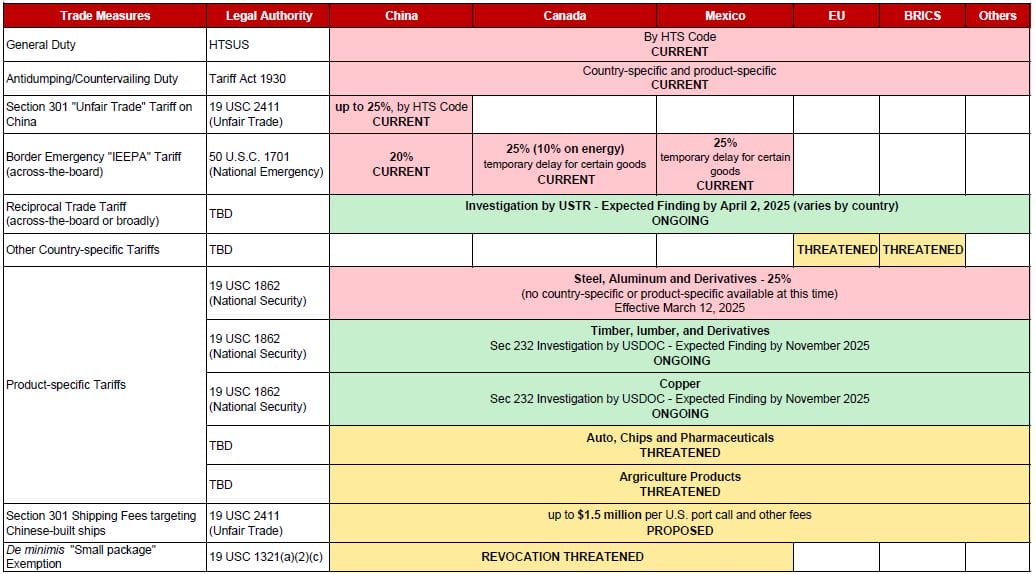Key Takeaways
- Imports from China have been most impacted by tariffs imposed to date. However, Canada and Mexico have also become primary targets for tariffs.
- Specific products already subject to, or threatened with, tariffs include steel, aluminum, lumber, copper, automobiles, chips, pharmaceuticals, and agricultural goods.
- Additional measures may be imposed in the coming months, including potential across-the-board “reciprocal trade” tariffs, tariffs on EU and BRICS members, and service fees on Chinese-built ships and their operators.
In just under two months since President Donald J. Trump assumed office, multiple tariff[1] measures have been implemented, with additional measures under consideration. These tariffs aim to regulate imports into the U.S. for certain products or from specific countries. This alert summarizes the actions that have been taken or are being evaluated. As developments in Washington, D.C., can change rapidly, it is crucial for companies to stay informed about U.S. trade policy to understand its potential impact on their operations.

Summary of Key U.S. Trade Measures (as of March 6, 2025)
China: U.S. trade measures heavily impact imports from China. Since 2018, Section 301 and Section 232 tariffs have been in place. Additionally, starting March 4, 2025, President Trump is imposing a 20 percent across-the-board tariff on Chinese goods. China has announced various retaliatory measures in response. President Trump has also threatened further actions, including “reciprocal trade” tariffs, product-specific tariffs, shipping fees on Chinese ships, and revocation of the de minimis exemption for shipments under $800.
Canada and Mexico: Due to border security concerns, the U.S. has implemented tariffs on imports from its neighboring countries, Canada and Mexico, two of its largest trading partners. At present, imports from these countries are subject to a general tariff rate of 25 percent, with energy products from Canada being an exception with a tariff rate of 10 percent. At the time of this alert, President Trump has decided to delay the 25 percent tariffs on auto products and most goods from Mexico for one month. Additionally, the U.S. Department of Commerce (USDOC) was instructed to examine the impact of lumber imports on the U.S. domestic industry and national security, with a focus on Canada, the primary supplier of lumber for the U.S. Canada and Mexico may also face significant effects from Section 232 tariffs on steel and aluminum products and other measures resulting from ongoing U.S. trade investigations. Canada and Mexico have announced various retaliatory measures. Negotiations to defuse the situation are ongoing but remain uncertain.
Ongoing investigations and other potential measures: Additional tariffs may be imposed in the coming months. The U.S. Trade Representative (USTR) will finalize its ongoing investigation on reciprocal trade issues in April, which might result in significant tariffs on the U.S.’s major trading partners, particularly those with substantial trade imbalances with the U.S. Additionally, USDOC is conducting investigations of the national security implications of imports of timber, lumber, derivatives and copper. These investigations are expected to conclude in November and could also lead to additional tariffs. President Trump has publicly identified autos, chips, pharmaceuticals and agricultural products as areas of particular concern and potential targets for tariffs.
USTR’s Section 301 investigation of Chinese-built ships has led to a proposal for service fees on these ships and their operators using U.S. ports, which will increase the cost of imported goods.
Considering the swiftly evolving U.S. trade policy landscape, it is expected that the U.S. government will rigorously implement its tariff measures through both civil and criminal enforcement mechanisms if necessary. Consequently, it is imperative for companies to understand and comply with the law when importing goods subject to tariffs.
[1] The terms “duty” and “tariff” are used interchangeably.
[View source.]